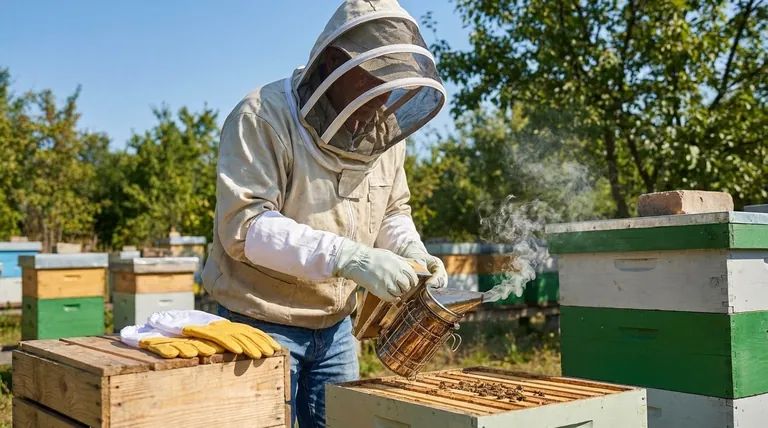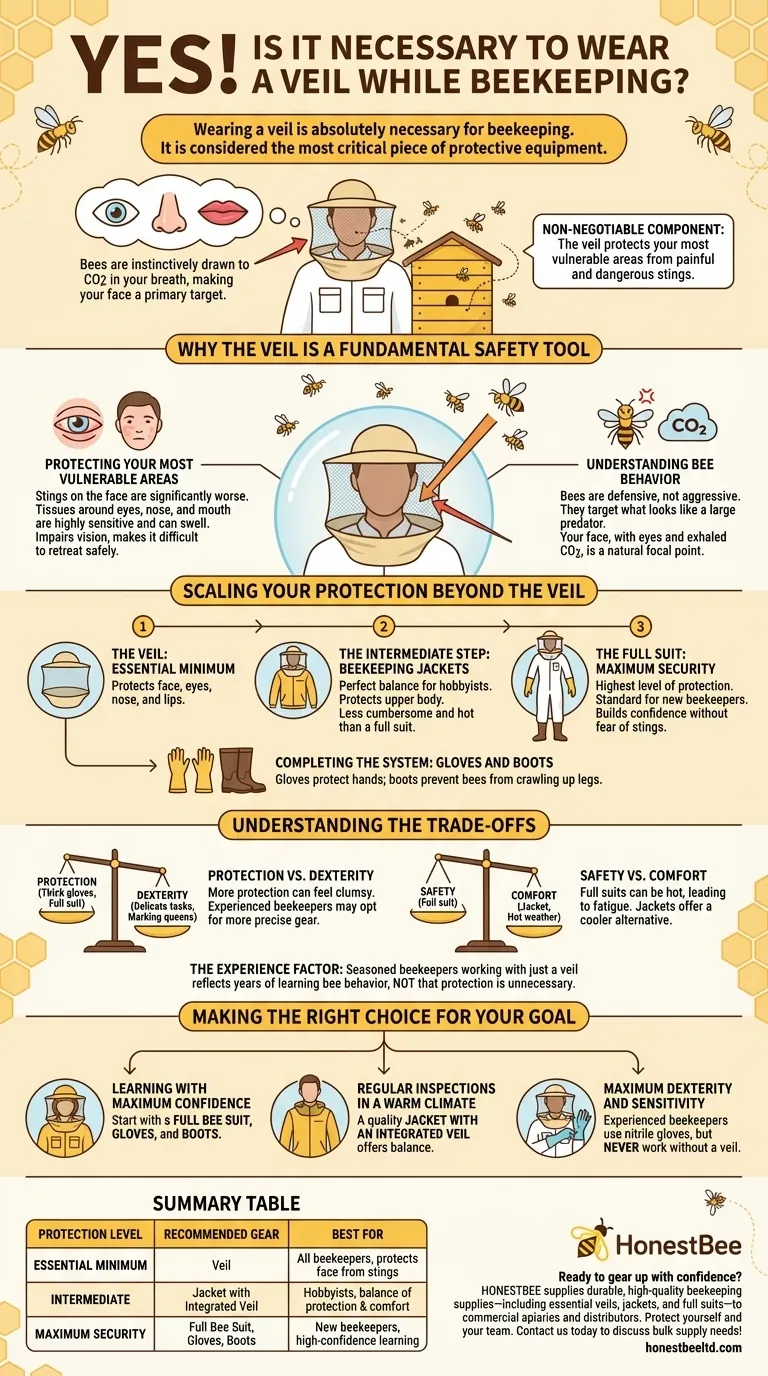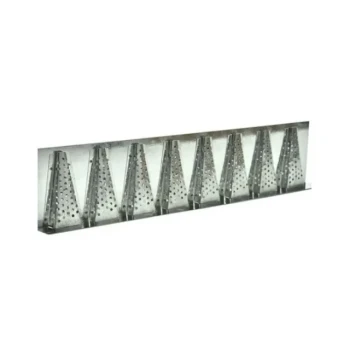Yes, wearing a veil is absolutely necessary for beekeeping. It is considered the most critical piece of protective equipment, regardless of your experience level. Bees are instinctively drawn to the carbon dioxide in your breath, making your face, eyes, nose, and lips a primary target for defensive stings.
Your choice of beekeeping gear involves a trade-off between protection, comfort, and dexterity. However, the veil is the one non-negotiable component that protects your most vulnerable areas from painful and potentially dangerous stings.

Why the Veil is a Fundamental Safety Tool
Protecting Your Most Vulnerable Areas
A bee sting is painful anywhere, but a sting on the face is significantly worse. The tissues around your eyes, nose, and mouth are highly sensitive and can swell considerably.
Protecting these areas is not just about comfort; it's about your ability to safely finish your work. A sting near the eye can impair your vision, making it difficult to close up the hive and retreat safely.
Understanding Bee Behavior
Bees are not typically aggressive, but they are defensive. When they perceive a threat to their hive, they target what looks like a large predator.
Your face, with its forward-facing eyes and exhaled CO2, is a natural focal point for their defensive response. A quality veil creates a secure barrier that keeps them at a safe distance from this high-risk zone.
Scaling Your Protection Beyond the Veil
While the veil is the bare minimum, most beekeepers opt for more comprehensive protection. The right choice depends on your comfort level, the temperament of your bees, and your experience.
The Intermediate Step: Beekeeping Jackets
For many hobbyists, a jacket with a built-in veil is the perfect balance. It protects your entire upper body, which is most likely to be near the hive entrance during an inspection.
This setup offers excellent protection while being less cumbersome and hot than a full suit.
The Full Suit: Maximum Security
A full-body bee suit offers the highest level of protection, covering you from your ankles to your neck. The veil is typically integrated directly into the suit's hood.
This is the standard recommendation for new beekeepers. It allows you to build confidence and learn to manage your hives without the fear and distraction of stings.
Completing the System: Gloves and Boots
Gloves are essential for protecting your hands, which are in the center of the action. Thick beekeeping gloves provide maximum protection, while thinner nitrile gloves offer greater dexterity.
Heavy-duty, high-top boots prevent bees from crawling up your pant legs, ensuring you are sealed and secure.
Understanding the Trade-offs
Choosing your gear requires balancing competing priorities. There is no single "best" setup for everyone.
Protection vs. Dexterity
Thicker gloves and full suits provide the most protection but can make you feel clumsy. This can make delicate tasks, like marking a queen or handling a single frame, more difficult. As you gain experience, you may opt for gear that allows for more precise movements.
Safety vs. Comfort
A full beekeeping suit can become extremely hot, especially during summer inspections. This can lead to fatigue and dehydration. A jacket offers a cooler alternative, but at the expense of lower-body protection.
The Experience Factor
You may see seasoned beekeepers working calmly with nothing more than a veil. This is not a sign that protection is unnecessary; it's a reflection of years spent learning to read a colony's mood and move with quiet confidence. Beginners should never attempt this.
Making the Right Choice for Your Goal
- If your primary focus is learning with maximum confidence: Start with a full bee suit, gloves, and boots. This removes the fear of stings, allowing you to focus on the bees.
- If your primary focus is regular, quick inspections in a warm climate: A quality jacket with an integrated veil offers a great balance of safety and comfort.
- If your primary focus is maximum dexterity and sensitivity: Experienced beekeepers may use nitrile gloves, but they never work without a veil to protect their face.
Ultimately, protective gear empowers you to be a calmer, more effective beekeeper.
Summary Table:
| Protection Level | Recommended Gear | Best For |
|---|---|---|
| Essential Minimum | Veil | All beekeepers, protects face from stings |
| Intermediate | Jacket with Integrated Veil | Hobbyists, balance of protection & comfort |
| Maximum Security | Full Bee Suit, Gloves, Boots | New beekeepers, high-confidence learning |
Ready to gear up with confidence? HONESTBEE supplies durable, high-quality beekeeping supplies and equipment—including essential veils, jackets, and full suits—to commercial apiaries and beekeeping equipment distributors through our wholesale-focused operations. Protect yourself and your team with gear designed for safety and efficiency.
Contact us today to discuss your bulk supply needs and get a quote!
Visual Guide

Related Products
- Beekeeping Gloves Goatskin Leather with Long Cotton Sleeve for Beekeepers
- Professional Insulated Plastic Bee Hives
- Wholesales Dadant Size Wooden Bee Hives for Beekeeping
- Professional Galvanized Hive Strap with Secure Locking Buckle for Beekeeping
- Langstroth Bee Hives Bee Keeping Box for Beginners Beekeeping
People Also Ask
- What are the arguments for and against using gloves in beekeeping? Balancing Protection and Dexterity
- Should beekeepers wear gloves, and why? Essential Protection for Beekeepers
- What is the safest way to handle frames in beekeeping? Master Gentle Handling for a Calm Hive
- Why do some experienced beekeepers choose not to wear gloves? For Superior Dexterity & Hive Welfare
- Why are protective gloves important in beekeeping? Boost Confidence & Safety in Your Apiary



















